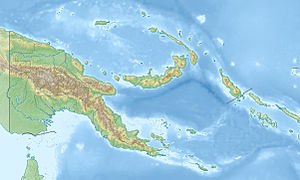Tabar Islands
| Tabar Islands | ||
|---|---|---|
| NASA satellite image of the Tabar Islands | ||
| Waters | Bismarcksee | |
| archipelago | Bismarck Archipelago | |
| Geographical location | 2 ° 50 ′ S , 151 ° 58 ′ E | |
|
|
||
| Number of islands | 3 | |
| Main island | Tabar | |
| Total land area | 270 km² | |
| Residents | 3920 (2000) | |
The Tabar Islands form a group of volcanic islands in the Bismarck Archipelago north of New Ireland . The three islands belong to the province of New Ireland , Papua New Guinea and are part of the Tabar- Lihir - Tanga - Feni chain of islands . The archipelago has an area of around 270 km². At the 2000 census, the population was 3,920.
The southern island of the group is Tabar , often called Big Tabar. The island of Tatau is centrally located, only separated from it by a narrow channel . These two islands were previously mistaken for one. To the north are Simberi and some smaller islands.
The archipelago was discovered for Europe in June 1616 by the Dutch navigators Jacob Le Maire and Willem Cornelisz Schouten . They were called Gardner or Gardener Islands and from Abel Tasman they were called Visscher Islands . From 1885 to 1899 the Tabar Islands belonged to the so-called "German Protected Area" of the New Guinea Company and from 1899 to 1914 to the German New Guinea colony . In 1914 the islands were conquered by Australian troops, and after the First World War they were administered as a mandate of the League of Nations of Australia. Since 1975 they have been part of the independent state of Papua New Guinea.
On Simberi, gold is mined in open-cast mining. One of the first to find gold on Tabar was the Swedish seafarer Carl Pettersson , whose life Astrid Lindgren is said to have served as the historical template for Pippi Longstocking's father Efraim Longstocking .
literature
- Heinrich Schnee (Ed.): German Colonial Lexicon . Volume 1: A - G. Quelle & Meyer, Leipzig 1920, p. 678.
Web links
- Tabar Islands on oceandots.com ( Memento from December 23, 2010 in the Internet Archive )

